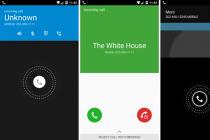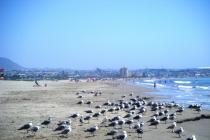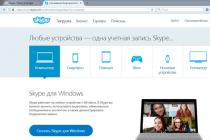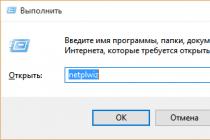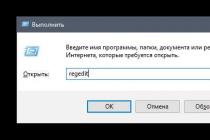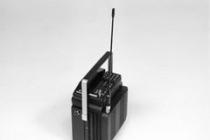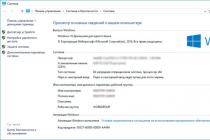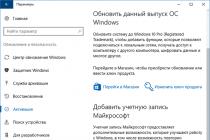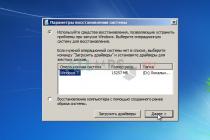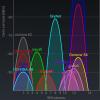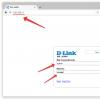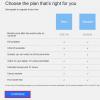The most common problem that users cannot open this file is an incorrectly assigned program. To fix this in Windows you need to right-click on the file, in the context menu, point to the "Open with" item, and select the "Select program ..." item in the drop-down menu. As a result, you will see a list installed programs on your computer, and you can choose the one that suits you. We also recommend checking the box next to "Use this app for all KML files".
Another problem that our users also encounter quite often is that the KML file is corrupted. This situation can arise in many cases. For example: the file was downloaded incompletely as a result server errors, the file was damaged initially, etc. To fix this problem, use one of the recommendations:
- Try to find the desired file in another source on the Internet. You may be lucky enough to find a more suitable version. Google search example: "File filetype: KML". Just replace the word "file" with the name you want;
- Ask to send you the original file again, it may have been damaged in transit;
KML is a file format used to display geographic data in an Earth browser such as Google Earth. KML uses a tag-based structure with nested elements and attributes and is based on the XML standard. All tags are case-sensitive and must appear exactly as they are listed in the. The Reference indicates which tags are optional. Within a given element, tags must appear in the order shown in the Reference. If you "re new to KML, explore this document and the accompanying samples files () to begin learning about the basic structure of a KML file and the most commonly used tags. The first section describes features that can be created with the Google Earth user interface. These features include placemarks, descriptions, ground overlays, paths, and polygons. The second section describes features that require authoring KML with a text editor. When a text file is saved with a .kml or .kmz extension, Earth browsers know how to display it. |
Tip: To see the KML "code" for a feature in Google Earth, you can simply right-click the feature in the 3D Viewer of Google Earth and select Copy. Then Paste the contents of the clipboard into any text editor. The visual feature displayed in Google Earth is converted into its KML text equivalent. Be sure to experiment with this feature.
For a discussion of how to use some of the key features in KML, see the.
Table of Contents
Basic KML Documents
The simplest kind of KML documents are those that can be authored directly in Google Earth — that is, you don "t need to edit or create any KML in a text editor. Placemarks, ground overlays, paths, and polygons can all be authored directly in Google Earth.
Placemarks
A Placemark is one of the most commonly used features in Google Earth. It marks a position on the Earth "s surface, using a yellow pushpin as the icon. The simplest Placemark includes only a
As an example, enable the "Absolute Positioning: Top left" folder in the file and you will see a screen overlay at the top left of the view window. This was created with the following KML code:
Positioning is controlled by mapping a point in the image specified by
Check the other examples in the folder to see how it is possible to obtain other fixed positions, and to create images that size dynamically with screen size. (Note that xunits and yunits can also be specified as "pixels" for precision control.) For further detail, see the.
Network Links
A network link contains a element with an
The
- An image file used by icons in icon styles, ground overlays, and screen overlays
- A model file used in the
element - A KML or KMZ file loaded by a Network Link
The specified file can be either a local file or a file on a remote server. In their simplest form, network links are a useful way to split one large KML file into smaller, more manageable files on the same computer.
So far, all of our examples have required that the KML code be delivered to Google Earth from the local machine. Network links give you the power to serve content from a remote location and are commonly used to distribute data to large numbers of users. In this way, if the data needs to be amended, it has to be changed only at the source location, and all users receive the updated data automatically.
CGI Scripting for KML
In addition to pointing to files containing static data, a network link "s
Two things are necessary for delivering KML through a network CGI:
When a call is made from the client (Google Earth) to the server, the server must (1) return a response code of HTTP 200 and (2) set the response "s content type to text / plain or application / vnd.google -earth.kml + xml.
The response must be valid KML. For complex applications, proper error handling is very important.
Tip: A simple way to handle errors is to parse the server "s error as the text for a folder name. For example, you could have the server return
The following examples use Python, but they are equally valid in any other scripting language.
Generating a Random Placemark
The following Python script generates random integer values for latitude and longitude and then inserts those values into the
#! / usr / bin / python import random latitude = random.randrange (-90, 90) longitude = random.randrange (-180, 180) kml = ("\ n ""
Here is an example of a KML file containing a Network Link that loads this Python script:
placemark on each call
View-Based Refresh Queries
A standard network link is a uni-directional link: data flows only from the server to Google Earth. The view-based refresh enables bi-directional communication. When the view-based refresh is active, Google Earth returns the view coordinates to the server at a specified time. This may be every n seconds, minutes, or hours, or once a certain amount of time has elapsed since the view stopped moving. See in the KML 2.2 Reference.
The coordinates are returned to the server by means of an HTTP GET that appends the coordinates as follows (this is the default bounding box information):
GET / path / to / sever / script / query? BBOX = HTTP / 1.1
If the request were made while the user was looking down on San Francisco, the coordinates might look as follows:
GET /path/to/server/script/query?BBOX=-122.497790,37.730385,-122.380087,37.812331 HTTP / 1.1
This feature can be used for some very creative applications, but to get you started, a simple example is presented below.
Tracking a Point Directly Under Your View
The following server-side Python script parses the return message sent by Google Earth and responds with a Placemark at the center of the screen. Each time the Network Link is refreshed, a new Placemark is generated.
#! / usr / bin / python import cgi url = cgi.FieldStorage () bbox = url ["BBOX"]. value bbox = bbox.split (",") west = float (bbox) south = float (bbox) east = float (bbox) north = float (bbox) center_lng = ((east - west) / 2) + west center_lat = ((north - south) / 2) + south kml = ("\ n ""
And here is the KML for the Network Link that loads the Python script:
the center of your screen and return a placemark.
The principle illustrated in this example can be used for some very complex applications. For example, if you have a database of geographic information, you can extract the coordinates of the viewer, make a call to the database for the data specific to the view, and return it to Google Earth as KML.
3 KML MIME Types
When responding to a request from Google Earth (or any Earth browser), a KML server must follow a certain set of rules so that Google Earth can correctly interpret its responses.
Upon success, the server must return a response code of HTTP 200 and set the response "s content-type to a suitable MIME type, as described here.
Google Earth reads KML and KMZ files. The MIME type for KML files is
- application / vnd.google-earth.kml + xml
The MIME type for KMZ files is
- application / vnd.google-earth.kmz
For Apache, add these lines to the httpd.conf file:
- AddType application / vnd.google-earth.kml + xml .kml
- AddType application / vnd.google-earth.kmz .kmz
See the Microsoft documentation for details on setting up MIME types on Microsoft "s IIS.
The body of the response must contain valid KML data, including the XML declaration (). If the server returns invalid KML, the Network Link will stop, deactivate, and output an error message.
What "s Next?
Ready for more? Check out the, which describes key KML features. Also, browse the for information on specific elements.
Except as otherwise noted, the content of this page is licensed under the Creative Commons Attribution 4.0 License, and code samples are licensed under the Apache 2.0 License. For details, see our. Java is a registered trademark of Oracle and / or its affiliates.
With the help of which geo-data from a table (I think that most of them habitually store information in XLS format) can be converted into a map in KML format - for viewing in Google maps or Google Earth. I note right away that there are other ways to create personal maps (maps of real estate objects, maps of your own movements around the planet or maps of the location of close and distant relatives, etc. :-)). One of the most obvious is to take advantage of Google service Map maker http://www.google.com/mapmaker... But let's get back to my method. What do we have at the entrance? Excel table with two sheets. The first page contains a list of Moscow metro stations and their GPS coordinates for your reference. On the second sheet, our data for presentation on the map in the following format:
- object number
-Type of real estate (1,2,3,4 - you can then decide which type of object corresponds to which marker)
-Short name of the object
-Description of the object
-Full link to the photo from http: //
-Link to a site with a detailed description or photo
-GPS1 object coordinates - latitude and longitude.
-GPS2
If you find the address you need on Google Maps, then the latitude and longitude can be determined as follows:
In the right upper corner Google Maps find "Link to this page"
Downloading the archive with templates and macros:
First file KML-Shablon-Map Is a table template to fill with your own data.
Second file kml-PERSONAL with macros. It must be copied on the local computer to a folder on the disk:
C: \ DocumentsandSettings \ User \ ApplicationData \
Microsoft \ Excel \ XLSTART
("User" is your login to log into the computer)
We go to Excel, edit the table for ourselves.
In the Tools menu, select Macro - Macros

In the options, we specify our file with the kml-PERSONAL macros and select the KML_XLS_Shablon macro. Then we press "Execute".

After that, a window appears to save the KML file - for example, enter Test.kml.
A very obligatory step. After the file is saved on the local disk, we find it, open it in an ordinary Windows Notepad (NotePad) and save it in UTF-8 format !!!

Ready.
Now KML can be opened with using google Earth.
To open a file in Google Maps, upload it to the server (you can create it somewhere on Narod.ru and upload it there if you don't have your own website).
Then we go to
Creating KML in ArcGIS for Desktop is a simple process with three main steps:
- User creates layers and maps in one of the ArcGIS Desktop applications: ArcMap, ArcGlobe, and ArcScene.
- Prepare layers and maps for conversion to KML by assigning specific properties and attributes to the data, resulting in generated file KML will meet your requirements as much as possible, easy to use and well designed.
- Create a KML file using one of two KML conversion tools: Layer in KML or Map in KML... You also have the option to create KML from a multipatch 3D feature class using the tool Multipatch in COLLADA.
Create layers and maps
Both feature and raster layers and ArcMap map documents (.mxd) can be converted to KML format. Before converting to KML, feature classes and raster datasets must first be added to the display (automatically create a layer from data sources) or converted to a layer using tools Create vector layer or Create raster layer.
KML created in ArcGIS for Desktop is a snapshot of layers and maps as they are converted to KML. The appearance of layers in ArcGIS for Desktop is largely the same as appearance KML; for example, if you want to display KML using a specific symbol or color, use ArcMap to symbolize the layer as needed, and then export it to KML.
Preparing layers and maps for conversion to KML
Layers
Many different features and properties of layers created in ArcGIS Desktop are taken into account when converting to KML, including visible attribute fields, transparency, labels, popup settings, and display symbology. When setting layer properties and data attributes, you need to make sure that the KML dataset you are creating meets your requirements and is easy to use and well designed. Apart from some of the exceptions noted below, the rule for converting a layer or map to KML is "what you see is what you get". The following table lists a number of steps you need to take in preparing your layers for conversion to KML.
Layer properties and KML conversion
| Property | Appearance | Description |
|---|---|---|
The ArcGIS feature layer will become a folder when converted to KML format. The layer name will be used as the name of the KML folder. |
||
Layer description |  | The layer description will be displayed as pop-up information for the folder. |
Layer Symbols |  | The layer legend set will be used in the KML. For feature layers, not all ArcGIS symbols are supported in the KML format. For line objects, only simple symbols with standard color and symbol width settings are supported; additional effects such as strokes, arrows, and layered and layered symbols are not supported. To display polygonal objects, only simple color fills and border lines can be used; Drawings, hatches, gradient fills are not supported, and the display of polygon border lines is subject to the restrictions set for the display of line objects. If your layer requires more than simple symbology, use the option Returns one composite image in instruments Layer in KML or Map in KML to convert objects with symbols into a bitmap containing complex symbols. |
Object name |  This example uses the United States FIPS Administrative Division Code for the name This example uses the United States FIPS Administrative Division Code for the name | If feature labels are enabled, the label field or expression will be used as the name source. If feature labels are enabled, the displayed label field or expression will be used as the name source. If none of these layer properties are specified, the values from the Name field will be used. |
Object inscription |  | If the layer labels are enabled, the label field or expression will be used as the name source for all KML objects. Note:Only point features will be labeled. For line and polygon features, centroids can be created and labeled to achieve a label effect. |
Fragment of an object |  | An object snippet can be set by changing the field alias to KMLSnippet. The values in the Snippet field of the vector layer will otherwise be used as snippets for all KML objects. |
Pop-up window with information on the object |  | By default, the pop-up window displays information from all visible fields in the layer. Bubbles for a KML layer can also be set using the HTML Bubbling Properties. If HTML popups are disabled, the PopupInfo field of the vector layer will be displayed using popup information when the KML object is clicked. These values can be numeric or text attributes, or HTML stored in the text box. |
Folders and subfolders |  The values in the FolderPath field are in the format Block Groups / Year / 2010. The values in the FolderPath field are in the format Block Groups / Year / 2010. | If the layer has a FolderPath field, the values of this field will be used to create the KML folder and subfolder structure. In this field, the forward slash character (/) is used as the separator between folders and subfolders. If the layer does not contain a FolderPath field, you can define the folder and subfolder structure using compound layers. Specify the composite layer itself as input to the Layer in KML tool to get its structure in the output KML. |
Object height |  | KML can be generated in 3D if the feature layer supports and has Z values in the geometry of the features. Also, if the layer has 3D rendering effects used in ArcGlobe or ArcScene (base elevations or extrusions), those 3D effects will be preserved in the output KML. If none of these layer effects are applied, the field attributes are used to control the 3D effects. A more detailed description is given in the next section on creating 3D images. |
Creation of 3D images
The following field attributes (all integers) are used to control the placement and properties of objects in 3D space (on or above a surface).
Attention:
KML uses the WGS84 coordinate system and meters as the unit of measure. When creating KML, it is assumed that the elevation values are in meters.
Layer Properties for 3D Conversion
| Field | Meaning: | Explanation |
|---|---|---|
AltMode | A value of 0 specifies the absolute height in KML and should be used if features have z-values. A value of -1 allows objects to be positioned relative to the ground. |
|
Base | Any numeric value | Any numeric value can be used. If used in relative placement (AltMode = -1), it controls the height of the object above the ground. Attention:If features have a z-value of 100 and are in an area where the earth's surface height is greater than 100, using absolute values will cause the features to appear below the earth's surface. |
Extruded | A value of 0 means no pulling, -1 means pulling. Pulling objects turns polygons into a kind of blocks, the sides of which go down to the surface of the earth. |
The green polygons in the back left are objects with no heights or Z-values, the red and gray objects in the front right have heights. Similar effects can be applied to objects with and without z-values. For example, green extruded polygons have no z-values, but they have the following fields: AltMode = -1, Base = 25, and Extruded = -1. The red extruded polygons have a z-value of 1300 and the following fields: AltMode = 0, Base = 0, and Extruded = -1. Because the red objects have elevation values, their position is set to absolute and only extrusion is applied to them.

Note:
Additional parameter of the Layer to KML tool, Freeze objects on the ground, ignores 3D settings, the ground surface will be draped with objects. This option is useful when creating KML from objects with z-values below ground level that do not require 3D effect. You can also use the Clamped field with a value of -1 to get the same effect, but on a per-object basis.
Cards
There are also map properties that you can use to check how documents converted to KML will look and behave. The following table lists a number of steps you need to take in preparing your maps for conversion to KML.
Map properties and KML conversion
| Parameter | Appearance | Description |
|---|---|---|
Map data frame name |  The New Orleans Admin data frame was selected for conversion to KML. The data frame includes two layers: Block Groups and Municipalities. The New Orleans Admin data frame was selected for conversion to KML. The data frame includes two layers: Block Groups and Municipalities. | Only one data frame can be exported to KML at a time. The name of the map data frame will be used as the top-level name in the KML data. |
Map data frame description |  | The data frame description will be displayed with a pop-up for top-level KML object information. |
A KML file stores geo-modeling data in XML format. It contains points, lines and images. Use XML to express geographic annotation and visualization by storing locations, image overlays, video links, and modeling information such as lines, shapes, 3D images, and points. Various geospatial software solutions use the KML format to put data in a format that other programs and web services can easily use.
Introduction
Keyhole Markup Language - XML notation for expressing geographic annotation and rendering in 2D maps and 3D browsers. KML was designed for use with Google Earth, which was originally called the Keyhole Earth Viewer. It was created by Keyhole. Inc, which was acquired by Google in 2004. This format became the international standard of the Open Geospatial Consortium in 2008.
Google Earth was the first program capable of viewing and graphically editing such files. Other projects such as Marble have also started to develop support for KML.
Application: how to create a KML format?
You can open the file with this extension in Google Maps. To do this, you need to place its location online and then enter the URL into the search box on Google Maps.
Google Earth was the first program that could view and edit these files, and it remains one of the most popular ways to work with geodata on the Internet. With a web page open, use the My Places menu item (bookmark icon) to download a KML file from your computer, or account Google Drive.
You can also open the files with any text editor (like Notepad ++). This will allow you to see a text version that includes coordinates, image links, camera angles, and timestamps.
If you want to convert KML to XML, you don't need to do the conversion. Since the format is actually just using the KML format extension), you can rename .KML to .XML so that it opens in your XML viewer.
You can also import the file directly to Google Maps. This is done on google page My maps when adding content to a new map layer. With the map open, select Import at any level to download the file from your computer or Google Drive. You can create a new layer using the Add Layer button.
Alternatively, you can create your own KML file and its URL in Google Maps by first linking your file URL using http://maps.google.com/maps?q=. For example, to open the same URL, you can use the following URL: http://maps.google.com/maps?q=http://mywebsite.com/myfile.kml.

The same operation works for Google Earth, a 3D viewing plug-in for our planet that can be added to a web browser.
Structure
The KML file format specifies a set of functions (labels, images, polygons, 3D models, text descriptions) for display in Google Maps, Google Earth, Maps, on mobile devices or any other geospatial software that implements KML encoding. Each location has a longitude and latitude. This format shares some of the same structural grammars as GML. Some information cannot be viewed on Google Maps or on mobile devices.
Data is very often distributed in the KMZ format, which are encrypted KML files with a .kmz extension. They must be compatible with legacy (ZIP 2.0) compression, or the .kmz file may not be unpacked.
Geodetic reference systems in KML
For its frame of reference, KML uses 3D geographic coordinates: longitude, latitude, and altitude. Longitudes, latitude components (decimal degrees) are determined according to the World Geodetic System 1984 (WGS84). The vertical component (height) is measured in meters from the WGS84 EGM96 Geoid vertical base. If elevation is not specified in the coordinate string (for example, -77.03647, 38.89763), then the default value for the elevation component is 0 (approximately sea level), that is, (-77.03647, 38.89763, 0).

The formal definition of the coordinate system (coded as GML) used in KML is contained in the OGC KML 2.2 specification. This definition refers to the EPSG CRS components.
Documentation
The KML 2.2 specification has been submitted to an open geospatial consortium to ensure its status as an open standard for all geo objects. In November 2007, a new working group was formed within the OGC to formalize the standard. Comments were requested on the proposed standard before January 4, 2008, and it became an official OGC standard on April 14, 2008.

The Standards Working Group finalized the KML 2.2 change requests and incorporated the accepted changes. The official OGC KML 2.3 standard was published on August 4, 2015.

